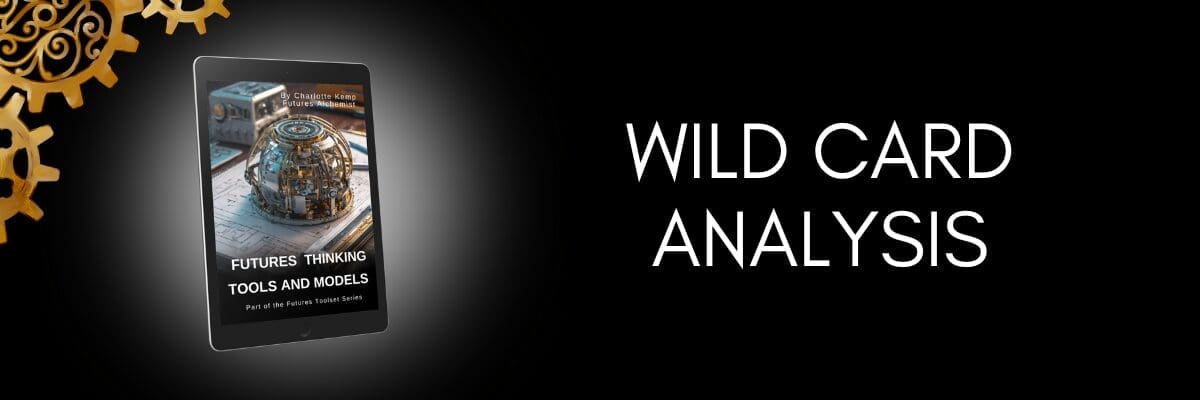
Introduction
Wild Card Analysis is a foresight technique used to explore low-probability but high-impact events that could dramatically alter the future. These events, sometimes called “Black Swans”, are not predicted by traditional trend analysis but have the potential to disrupt systems, markets, or societies in profound ways.
The goal of the analysis is not to predict when such events will occur, but to expand strategic imagination and test resilience by asking, What if something unexpected happens, what would we do?
Wild Card Analysis helps organisations and leaders identify vulnerabilities, develop contingency strategies, and cultivate agility in the face of uncertainty.
What it looks like
Using Wild Card Analysis usually follows a structured, creative process that combines imagination with strategic reasoning:
- Identify potential wild cards.
- Brainstorm possible extreme or disruptive events across domains (political, economic, social, technological, environmental, legal).
- Example prompts: “What could completely upend our industry?” or “What would make our current strategy irrelevant overnight?”
- Describe the event in detail.
- What exactly happens? How does it begin? Who or what is affected?
- Assess impacts.
- Map the immediate and longer-term consequences for your organisation, stakeholders, and society.
- Evaluate preparedness and response.
- How resilient is your system? What early warning signs could you monitor? What contingency plans could mitigate damage or capture opportunity?
- Integrate findings into strategy.
- Use insights to inform risk management, innovation, and adaptive policy design.
Workshops often encourage bold, even playful thinking, since the goal is not accuracy but imaginative preparedness.
Examples
History is full of wild cards that reshaped the future:
- The COVID-19 pandemic (2020)
- A global health crisis that disrupted every sector, accelerated digital transformation, and rewired global supply chains.
- The fall of the Berlin Wall (1989)
- A sudden political shift that ended the Cold War and transformed global geopolitics.
- 9/11 terrorist attacks (2001)
- A low-probability, high-impact event that fundamentally changed global security policies and perceptions.
- The invention of the World Wide Web (1991).
- Although not a “disaster,” it was a wild card in its own right, an unexpected innovation that reshaped communication, economy, and culture.
In foresight work, governments and corporations use such historical examples to prepare for future wild cards—such as AI consciousness, cyber collapse, solar flares, or radical social shifts.
How and when it is used
Wild Card Analysis is used when organisations or policymakers want to:
- Test the robustness of strategies under extreme or unexpected conditions.
- Expand awareness of uncertainties that conventional forecasting overlooks.
- Encourage creative, divergent thinking in risk and resilience planning.
- Stimulate innovation, as considering “impossible” futures often sparks new opportunities.
It is commonly applied in:
- Scenario planning and stress testing exercises.
- National security and emergency management.
- Corporate strategy and innovation foresight.
- Climate resilience and sustainability planning.
- Wild Card Analysis is especially useful in volatile environments, where leaders must learn to “expect the unexpected.”
Notable Examples
The European Commission’s Joint Research Centre regularly conducts Wild Card and Weak Signal analyses to support EU policy foresight, tracking unusual developments that might have outsized future effects.
Shell’s Scenario Team, famous for its foresight work, uses wild card thinking to test whether their long-term energy scenarios remain viable under extreme conditions (e.g., sudden oil bans, breakthroughs in fusion energy).
In education foresight, some facilitators use “Wild Card Debates”. Students draw random disruptive events (e.g., “AI replaces all teachers”) and must argue how a future school system could adapt.
Artists and speculative designers explore wild cards through exhibitions or storytelling, imagining worlds where climate reversal technology works too well, or where humans communicate telepathically.
Healthcare futures labs simulate “wild card pandemics” or genetic breakthroughs to stress-test public health systems.
These applications show that wild card thinking is as much about creative agility as about risk mitigation.
Origin
The term “wild card” entered futures studies in the 1970s, popularised by futurists such as John Petersen of The Arlington Institute and later elaborated by Elina Hiltunen, a Finnish futurist and researcher who has written extensively on Wild Cards and Weak Signals (2010s).
However, the concept draws from earlier systems theory and military foresight, where planners used “shock scenarios” or “strategic surprises” to test defence readiness.
The European Foresight Monitoring Network in the 1990s and 2000s formally incorporated Wild Card Analysis into its methodological toolkit, linking it with early warning systems and horizon scanning.
Today, Wild Card Analysis remains a core component of strategic foresight and resilience planning, reminding leaders that even the most unlikely event can redefine the future.




